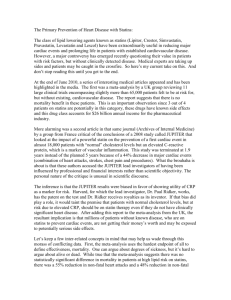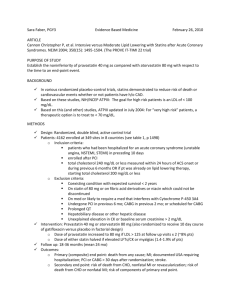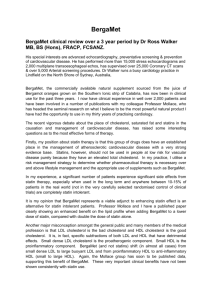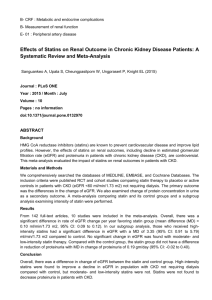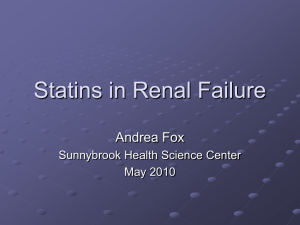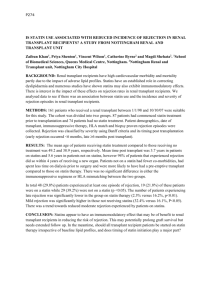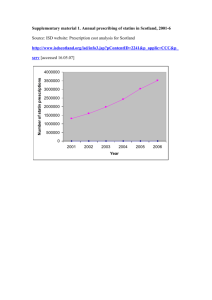Supplementary table 1: Potential anti-tumour
advertisement
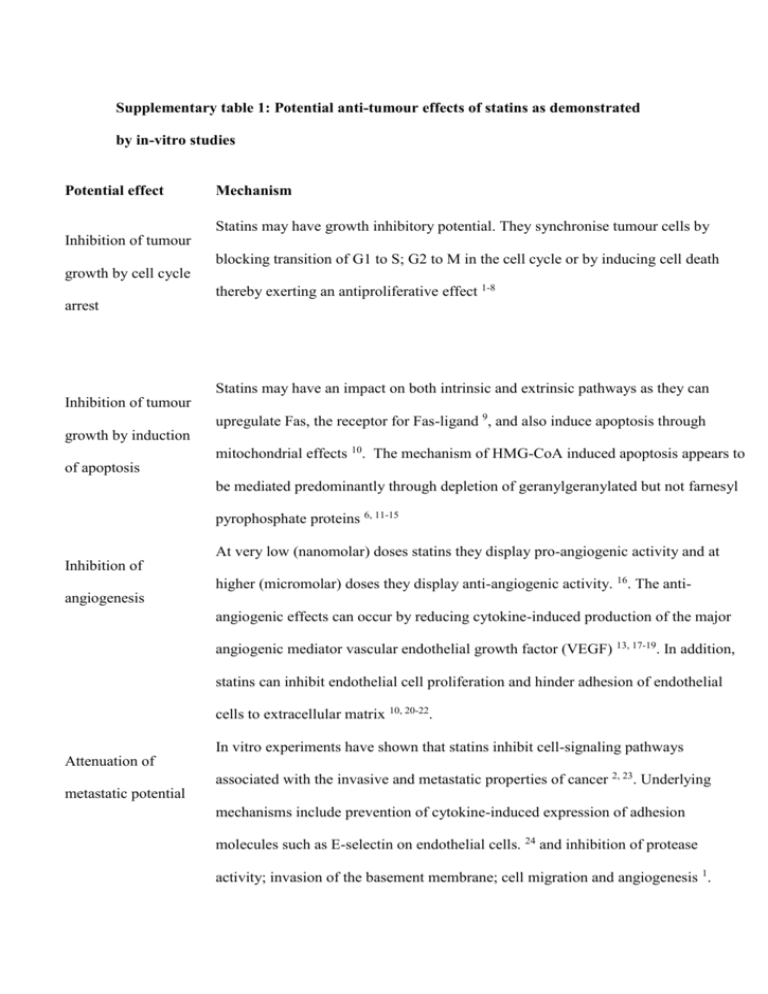
Supplementary table 1: Potential anti-tumour effects of statins as demonstrated by in-vitro studies Potential effect Mechanism Statins may have growth inhibitory potential. They synchronise tumour cells by Inhibition of tumour blocking transition of G1 to S; G2 to M in the cell cycle or by inducing cell death growth by cell cycle thereby exerting an antiproliferative effect 1-8 arrest Statins may have an impact on both intrinsic and extrinsic pathways as they can Inhibition of tumour upregulate Fas, the receptor for Fas-ligand 9, and also induce apoptosis through growth by induction mitochondrial effects 10. The mechanism of HMG-CoA induced apoptosis appears to of apoptosis be mediated predominantly through depletion of geranylgeranylated but not farnesyl pyrophosphate proteins 6, 11-15 At very low (nanomolar) doses statins they display pro-angiogenic activity and at Inhibition of higher (micromolar) doses they display anti-angiogenic activity. 16. The antiangiogenesis angiogenic effects can occur by reducing cytokine-induced production of the major angiogenic mediator vascular endothelial growth factor (VEGF) 13, 17-19. In addition, statins can inhibit endothelial cell proliferation and hinder adhesion of endothelial cells to extracellular matrix 10, 20-22. In vitro experiments have shown that statins inhibit cell-signaling pathways Attenuation of associated with the invasive and metastatic properties of cancer 2, 23. Underlying metastatic potential mechanisms include prevention of cytokine-induced expression of adhesion molecules such as E-selectin on endothelial cells. 24 and inhibition of protease activity; invasion of the basement membrane; cell migration and angiogenesis 1. Statins have been found to reduce the expression of Fas-ligand on tumour cells, a Stimulation of factor known to confer resistance against cellular immunity 10. cellular immunity Statins have also been found to potentiate the antitumour effects of some cytokines Potentiating the and other chemotherapeutics 6, 11, 17, 23, 25-33 antitumour effects of other agents Supplementary table 2. Published cohort studies assessing the association between colorectal cancer and statin use Study Year Population Cohort No. No. cases % Mean Definiti Statin type Risk All Risk CRC size CRC in statin Male follow- on of cancers RR (95% cases users up (yrs) statin Adjusted CI) use RR (95% CI) Friis 34 2005 Pharmacy 334,754 129 55 57% statin 3.3 ≥2 All statins 0.86 0.85 (0.651.11) database & users; 56% prescrip (0.78- Danish Cancer nonstatin tions 0.95) Registry analysis lipidlowering (Denmark) drug users; 50% base population Jacobs 35 2006 CPS-II Nutrition 132,136 815 183 NK 5 Current Any lipid N/A Current use: cohort(USA) (current use & lowering RR=1.03 1997-2001 users) 72 ≥5 yrs agent 95%CI=0.85 questionnaire- (≥5yrs use (estimated -1.26 ; based study users) 53% ≥5 yrs use: participants RR=1.09 using 95%CI=0.83 statins) -1.43. 249 190 18.2% statin 2.9 ≥3 Setoguchi 2007 65+yr olds statin 24,439 All statins N/A HR=0.96 16 initiators and statin users; 16.4% prescrip 95%CI=0.70, glaucoma drug users; glaucoma drug tions 1.31 users enrolled in 7,284 users filled Medicare & drug glaucom post benefit programs a drug initial 1994-2003 users statin Flick H 36 2009 (Pennsylvania prescrip USA) tion 45-69 yr old men 69,115 171 56 100% Max Ever 3.5yrs use (0.61, 1.3) healthcare ≥5yrs HR 0.83 maintenance estimat (0.43, 1.63) organisation ed enrolled in a All statins NA HR 0.89 prepaid integrated Singh H 37 2009 MHHL 35,739 population users; registry 010495 to 377,532 311295 &>40yrs neveruse 6637 402 51.8% statin Median ≥2 users; 46.4% follow- prescrpt 95% CI 1.02, nonusers up 3 ions 1.25 years All statins IRR 1.13 Supplementary table 3. Published case-control studies to date assessing the association between colorectal cancer and statin use Study Year Population No. CRC % Mean Definition of cases; no. Male statin statin use Controls (CRC use(yrs) Statin type All CRC OR (95% CI) cancers Adjuste cases;co d OR ntrols) (95% CI) Blais 38 Graaf 39 2000 2004 Quebec 542 cases; 44.6: Administrative 5420 31.2 Health Database controls Dutch Database of 3,129 8 cities cases; 49:49 2.7 7.2 ≥1prescription Lovastatin; 0.72 Adjusted 0.67 (0.33- Pravastatin (0.57- 1.8) Simvastatin 0.92) ≥1prescription Pravastatin; 0.8 Adjusted 1.07 (0.65- Simvastatin; (0.66- 1.74) 16,976 Cerivastatin; 0.96) controls Atorvastatin; Fluvastatin Kaye 40 2004 UK General 3,244 51.1: Practice Database cases; 50.2 6.4 ≥1prescription All 1.0 (0.9- Adjusted 0.9 (0.6-1.3) 1.2) 14,844 controls Poynter 2005 41 Coogan 42 2007 Israeli population- 1953 51.2: Min based study 1998- cases; 51.2 5yrs use 2004 >5 yrs of use All but most NA Unadjusted 0.5 (0.4- commonly 0.63); 2015 Simvastatin & Adjusted 0.53 (0.38- controls Pravastatin 0.74) Massachusetts 1809 54.8: population-based cases; 54.8 study Jan 1st 2001Nov 30th 2004. NK >3months use All but most NA Unadjusted 0.82 (0.7- and at least 3 commonly 0.95); 1809 times per Atorvastatin Adjusted 0.92 (0.78- controls week 1.09) Coogan 2007b 43 Hospital-based 4,913 47.9: NK At least All types 1.0 Adjusted 0.8 (0.5-1.2) study (NY; cases; 46.6 Philadelphia; 3900 week for ≥3 Baltimore) controls months ≥prescription Atorvastatin; NA 0.93 (0.83-1.04) in 13-48mths Cerivastatin; NA 0.69 (0.45-1.06) 4times per 1991 - 2005 commencing ≥1 year pre admission Vinogra 2007 QReseach database 5686 55.9:56. NK dova 44 including 454 cases: 1 general practice 24982 prior to index Fluvastatin; populations (1995- controls date (i.e. date Pravastatin; 2005) with >4yrs of diagnosis Simvastatin notes as noted in database) Hoffme 2007 Population based 540cases: 58:57 6.1yrs At least 2x/wk Atorvastatin; ister 45 study in Rhine- 614 Neckar-odenwald controls for ≥1yr Fluvastatin; rgn of SW 1-4yrs use Germany. ≥30yrs 2008 46 Lovastatin; 0.58 (0.33-1.04) Pravastatin; ≥5yrs use old Farwell Cerivastatin; Veteran Affairs 687 cases: admin & clin database with VA NK NK Simvastatin 0.71 (0.39-1.28) >2prescription Atorvastatin; 0.74 62155 s within 1yr Fluvastatin; (0.7- controls and continued Lovastatin; 0.78) New England filling of Pravastatin; VISN-1 pharmaco prescriptions Simvastatin epidemiology for ≥1yr HR 0.65 (0.55-0.78) database Yang 47 2008 GPRD comprising 4432 54.5:44. Min 5 700 General cases;442 2 yrs use ≥5 yrs of use Atorvastatin; Cerivastatin; NA 1.1 (0.5-2.2) practices in UK. 92 ≥50yrs and ≥5yrs controls Fluvastatin; ≥10 yrs of use Lovastatin; CRC-free f/u in Pravastatin; database. 1987- Simvastatin 1.3 (0.6-2.7) 2002 0:0 NK ≥1prescription Fluvastatin; Shadma 2009 Wisconsin Ca 657 cases: n 48 registry 1999-2001 1342 Lovastatin; & matched with controls Pravastatin; community controls <3yrs use NA Simvastatin 1.17 (0.74-1.85) 1.07 (0.56-2.03) (licensed drivers & ≥3yrs use medicare 1.27 (0.68-2.38) beneficiaries) Haukka 49 2010 National Finnish 5016 database1996-2005 cases: (all statin users with 939946 NK NK ≥1prescription Atorvastatin; RR 0.98 Colon: RR 1.01 (0.98- Cerivastatin; (0.98- 1.04) Fluvastatin; 0.99) no dx of Ca controls Lovastatin; Rectum RR 0.96 (0.92- matched with one Pravastatin; 0.99) non-user) – total Rosuvastatin; 944962 Simvastatin Supplementary table 4. Characteristics of statin users versus non-users among control patients Variable No statin Statin use* P- use* (n=250) (n=44) value† 61.54 (11.01) 65.7 (7.4) 0.017 Men 130 (52.0) 31 (70.5) Women 120 (48.0) 13 (29.5) Low 223 (100) 42 (97.7) Mdm/High 0 (0) 1 (2.3) Never 79 (31.6) 11 (25.0) Former 92 (36.8) 23 (52.3) Current 37 (14.8) 8 (18.2) Not known 42 (16.8) 2 (4.5) 0 105 (42.0) 23 (56.1) <3.5 52 (26.2) 8 (19.2) 3.5-7.0 23 (11.6) 6 (14.4) >7.0 18 (9.1) 4 (9.6) 68 (27.2) 12 (28.6) Age at recruitment Sex 0.026 FH Cancer risk n/a Smoking status 0.28 Physical activity (Cycling & other sport in hours/weel) ‡ BMI‡ <25 0.81 25-29.9 92 (44.4) 13 (31.0) >30 47 (22.7) 17 (40.5) 0.021 Alcohol intake (g/day) ‡ 12.9 (14.0) 12.4 (13.3) 0.42 Energy intake ((kJ/day) ‡ 11235 (5064) 10175 (2643) 0.27 1 27 (10.8) 6 (13.6) 2 57 (22.8) 9 (20.5) 3 67 (26.8) 12 (27.3) 4 57 (22.8) 9 (20.5) 5 20 (8.0) 2 (4.5) 6 21 (8.4) 6 (13.6) 7 1 (0.4) 0 0.95 PMH Bowel disease (incl IBS) 19 (9.2) 4 (9.8) 0.92 PMH Cancer 10 (4.8) 3 (7.1) 0.53 Yes 61 (24.4) 26 (59.1) No 21 (8.4) 1 (2.3) Not known 168 (67.2) 17 (38.6) Yes 35 (14.0) 5 (11.4) No 61 (24.4) 7 (15.9) Not known 154 (61.6) 32 (72.7) Yes 36 (14.4) 4 (9.1) No 59 (23.6) 8 (18.2) DEPCAT†† ‡ Regular use of NSAIDs** 0.052 HRT use 0.73 Hormonal contraception use 0.76 Not known 155 (62.0) 32 (72.7) * Mean values and in parenthese standard deviations for quantitative variables; number of subjects and in parentheses percentages for categorical variables † P-values from the Pearson χ2 for categorical variables; from t-test for continuous variables. All statistical tests were 2-sided ‡ OR, 95% CI and P-value were computed from the logarithmic transformed variable ** Regular use = at least four times a week for at least one month †† DEPCAT (Carstairs deprivation index) based on the 2001 Census data; 7 categories ranging from very low deprivation (DEPCAT 1) to very high deprivation (DEPCAT 7) Supplementary table 5. Characteristics of statin users versus non-users among female controls Variable No statin use* Statin OR P- (n=120) use* (95% CI) value (n=13) Age at recruitment 61.4 (11.9) 64.5 (6.4) 0.98 (0.92, 0.35 1.03) FH Cancer risk Low 106 (100.0) 12 (92.3) n/a n/a Mdm/High 0 (0) 1 (7.7) Never 48 (40.0) 4 (30.8) 0.81 (0.36, 0.62 Former 33 (27.5) 7 (53.8) 1.85) Current 14 (11.7) 1 (7.7) Not known 25 (20.8) 1 7.7) 46 (51.1) 8 (66.7) Smoking status Physical activity (Cycling & other sport in hours/week) ‡ 0 0.83 (0.25, 0.76 2.72) <3.5 27 (30.0) 1 (8.3) 3.5-7.0 10 (11.1) 3 (25.0) >7.0 7 (7.8) 0 <25 35 (37.6) 2 (16.7) 0.004 (0.0, 25-29.9 39 (41.9) 2 (16.7) 0.17) BMI‡ 0.004 >30 19 (20.4) 8 (66.7) Alcohol intake (g/day) ‡ 6.86 (7.96) 6.85 1.12 (0.72, (10.23) 1.73) 9431 1.62 (0.30, (3067) 8.67) Energy intake ((kJ/day) ‡ 10464 (6092) 0.62 0.57 DEPCAT†† ‡ 1 12 (10.0) 0 0.88 (0.59, 2 24 (20.0) 4 (30.8) 1.29) 3 32 (26.7) 4 (30.8) 4 29 (24.2) 1 (7.7) 5 10 (8.3) 1 (7.7) 6 13 (10.8) 3 (23.1) 7 0 (0) 0 PMH Bowel disease (incl 14 (14.7) 1 (7.7) IBS) PMH Cancer 0.53 (0.06, 0.50 0.55 4.40) 5 (5.3) 2 (16.7) 3.60 (0.62, 0.80 21.0) Regular use of NSAIDs** Yes 29 (24.2) 6 (46.2) 0.99 No 12 (10.0) 0 Not known 79 (65.8) 7 (53.8) Yes 35 (29.2) 5 (38.5) 1.22 (0.36, No 60 (50.0) 7 (53.8) 4.15) Not known 25 (20.8) 1 (7.7) HRT use 0.75 Hormonal contraception use Yes 36 (30.0) 4 (30.8) 0.81 (0.23, No 58 (48.3) 8 (61.5) 2.87) Not known 26 (21.7) 1 (7.7) 0.74 * Mean values and in parenthese standard deviations for quantitative variables; number of subjects and in parentheses percentages for categorical variables † P-values from the Pearson χ2 for categorical variables; from t-test for continuous variables. All statistical tests were 2-sided ‡ OR, 95% CI and P-value were computed from the logarithmic transformed variable ** Regular use = at least four times a week for at least one month †† DEPCAT (Carstairs deprivation index) based on the 2001 Census data; 7 categories ranging from very low deprivation (DEPCAT 1) to very high deprivation (DEPCAT 7) n/a one variable =zero therefore not possible to calculate OR Supplementary table 6. Characteristics of statin users versus non-users among male controls Variable Age at recruitment No statin Statin OR P- use* use* (95% CI) value (n=117) (n=31) 61.6 (10.2) 66.2 (7.9) 0.95 (0.90, 0.023 0.99) FH Cancer risk Low 117 (100.0) 30 (96.8) n/a 0.051 Mdm/High 0 1 (3.2) Never 31 (23.8) 7 (22.6) 0.86 (0.48, 0.62 Former 59 (45.4) 16 (51.6) 1.55) Current 23 (17.7) 7 (22.6) Not known 17 (13.1) 1 (3.2) 59 (54.6) 15 (51.7) Smoking status Physical activity (hrs) 0 (Cycling & other sport)‡ 1.32 (0.66, 0.43 2.64) <3.5 25 (23.1) 7 (24.1) 3.5-7.0 13 (12.0) 3 (10.3) >7.0 11 (10.2) 4 (13.7) <25 33 (28.9) 10 (33.3) 0.43 (0.04, 25-29.9 53 (46.5) 11 (36.7) 4.58) BMI‡ 0.48 >30 28 (24.6) 9 (30.0) Alcohol intake (g/day) ‡ 18.0 (15.8) 14.8 (13.8) 1.30 (0.94, 0.12 1.81) Energy intake ((kJ/day) ‡ 11868 10494 3.10 (0.75, (3946) (2431) 12.75) 1 15 (11.5) 6 (19.4) 1.02 (0.77, 2 33 (25.4) 5 (16.1) 1.35) 3 35 (26.9) 8 (25.8) 4 28 (21.5) 8 (25.8) 5 10 (7.7) 1 (3.2) 6 8 (6.2) 3 (9.7) 7 1 (0.8) 0 PMH Bowel disease (incl IBS) 5 (4.5) 3 (10.3) 0.12 DEPCAT†† ‡ 2.45 (0.55, 0.90 0.24 10.90) PMH Cancer 5 (4.4) 1 (3.3) 0.75 (0.08, 0.80 6.69) Regular use of NSAIDs** 32 (24.6) 20 (64.5) 5.63 (0.66, Yes 9 (6.9) 1 (3.2) 47.82) No 89 (68.5) 10 (32.3) n/a n/a 0.11 Not known HRT use Yes No Not known n/a n/a Hormonal contraception use n/a n/a n/a n/a Yes No Not known * Mean values and in parenthese standard deviations for quantitative variables; number of subjects and in parentheses percentages for categorical variables † P-values from the Pearson χ2 for categorical variables; from t-test for continuous variables. All statistical tests were 2-sided ‡ OR, 95% CI and P-value were computed from the logarithmic transformed variable ** Regular use = at least four times a week for at least one month †† DEPCAT (Carstairs deprivation index) based on the 2001 Census data; 7 categories ranging from very low deprivation (DEPCAT 1) to very high deprivation (DEPCAT 7) n/a one variable =zero therefore not possible to calculate OR Supplementary Table 7 AJCC distribution according to statin use Statin use description Status Statin use: at least 1 prescription No Yes Statin use: at least 1 prescription dispensed before diagnosis Statin use: 2+ prescriptions p-value No Yes p-value No Yes Statin use: 2+ prescriptions dispensed before diagnosis p-value No Yes p-value AJCC 1 54 (80.6%) 13 (19.4%) 0.46 54 (91.5%) 5 (8.5%) 0.96 56 (83.6%) 11 (16.4%) 0.58 54 (91.5%) 5 (8.5%) 0.99 2 82 (78.9%) 22 (21.1%) 3 73 (81.1%) 17 (18.9%) 4 37 (90.2%) 4 (9.8%) 82 (91.1%) 8 (8.9%) 73 (89.0%) 9 (11.0%) 37 (90.2%) 4 (9.8%) 84 (80.8%) 20 (19.2%) 76 (84.4%) 14 (15.6%) 37 (90.2%) 4 (9.8%) 82 (91.1%) 8 (8.9%) 74 (90.2%) 8 (9.8%) 37 (90.2%) 4 (9.8%) Supplementary table 8. Published meta-analyses of RCTs investigating the association between colorectal cancer risk and statin use Authors Year of No. of Total number of Mean follow Colorectal Cancer publication studies participants (statin up (yrs) incidence included users:controls) Comment Risk Ratio/OR (95% CI) (random effects model) Bjerre LM et al 50 2001 2 10,764 ≈5 No value given For Ca overall the findings were RR 0.999 (0.99-1.01).In considering site-specific Ca outcomes the outcome was not statistically significant. Bonovas S et al 51 Aug 2007 6 55,113 5.9 RR 0.95 (0.8 to 1.13) (27,557:27,556) Browning DRL Martin RM 52 Nov 2006 6 45430 ≤5 RR 1.02 (0.87-1.19) 3 20063 >5 RR 1.02 (0.79-1.30) Dale 53 Jan 2006 4 27,972 (13,984:13,988) ≥1 OR 0.95 (0.73 to 1.25) p-value 0.24 Supplementary table 9. Published meta-analyses of observational studies investigating the association between colorectal cancer risk and statin use Authors Year of No. of Total number of CRC incidence publication studies participants (statin RR/ OR (95% CI) included users:controls) (random effects model) Browning and Martin 52 2007 5 509051 RR 0.84 (0.59-1.21) p=0.36 Bonovas et al 54 2007 12 1.5 million RR 0.92 (0.88-0.96) Taylor M et al 55 2008 6 969636 OR 0.89 (0.82-0.97) Supplementary table 10. Quantity of missing data for cases and controls Variable Cases (n=309) No(%) Controls (n=294) Family history of CRC 22 (7) 28 (10) Smoking history 78 (25) 44 (15) Physical activity 88 (28) 55 (19) BMI 79 (26) 45 (15) Alcohol 98 (32) 59 (20) Energy 98 (32) 59 (20) Deprivation category 0 (0) 0 (0) PMH Cancer 77 (25) 43 (15) PMH Bowel disease 79 (21) 47 (16) NSAID use 78 (25) 43 (15) Regular NSAID use 116 (34) 47 (16) Variable Cases (n=149) Controls (n=133) HRT use 42 (28) 25 (19) Hormonal contraception use 42 (28) 25 (19) Supplementary figure 1. Annual prescribing of statins in Scotland, 2001-6 Source: ISD website: Prescription cost analysis for Scotland http://www.isdscotland.org/isd/info3.jsp?pContentID=2241&p_applic=CCC&p_serv [accessed 16.05.07] Number of statin prescriptions 4000000 3500000 3000000 2500000 2000000 1500000 1000000 500000 0 2001 2002 2003 2004 Year 2005 2006 Supplementary figure 2. Mechanism of data linkage via the Health Informatics Centre NHS Paper prescription ID Health Informatics centre Drug data CHI Enter data, find CHI Link using CHI SOCCS study data ID University Find CHI via ISD SOCCS study data - CHI Drug data, SOCCS study data CHI Delete CHI Drug data, SOCCS study data Analysis University References 1. Graaf MR, Richel DJ, van Noorden CJ, Guchelaar HJ. Effects of statins and farnesyltransferase inhibitors on the development and progression of cancer. Cancer Treatment Reviews 2004;30(7):609-41. 2. Guruswamy S, Rao CV. Multi-target approaches in colon cancer chemoprevention based on systems biology of tumor cell-signaling. Gene Regulation and Systems Biology 2008(of Publication: 2008):2008(2)(pp 163-176), 08. 3. Hopfner M, Sutter AP, Huether A, Baradari V, Scherubl H. Tyrosine kinase of insulin-like growth factor receptor as target for novel treatment and prevention strategies of colorectal cancer. World Journal of Gastroenterology 2006;12(35):563543. 4. McAnally JA, Jung M, Mo HB. Farnesyl-O-acetylhydroquinone and geranyl-O-acetylhydroquinone suppress the proliferation of murine B16 melanoma cells, human prostate and colon adenocarcinoma cells, human lung carcinoma cells, and human leukemia cells. Cancer Letters 2003;202(2):181-92. 5. Ukomadu C, Dutta A. p21-dependent inhibition of colon cancer cell growth by mevastatin is independent of inhibition of G(1) cyclin-dependent kinases. Journal of Biological Chemistry 2003;278(44):43586-94. 6. Xiao H, Zhang Q, Lin Y, Reddy BS, Yang CS. Combination of atorvastatin and celecoxib synergistically induces cell cycle arrest and apoptosis in colon cancer cells. International Journal of Cancer 2008;122(9):2115-24. 7. Jakobisiak M, Bruno S, Skierski JS, Darzynkiewicz Z. Cell cycle-specific effects of lovastatin. . Proceedings of the National Academy of Science 1991;88:362832. 8. Keyomarsi K, Sandoval L, Band V, Pardee A. Synchronization of tumor and normal cells from G1 to multiple cell cycles by Lovastatin. . Cancer Research 1991;51:3602-9. 9. Gniadecki R. Depletion of membrane cholesterol causes ligand-independent activation of Fas and apoptosis. Biochem Biophys 2004;320:165-9. 10. Sleijfer S, van der Gaast A, Planting AST, Stoter G, Verweij J. The potential of statins as part of anti-cancer treatment. European Journal of Cancer 2005;41(4):516-22. 11. Agarwal B, Bhendwal S, Halmos B, Moss SF, Ramey WG, Holt PR. Lovastatin augments apoptosis induced by chemotherapeutic agents in colon cancer cells. Clinical Cancer Research 1999;5(8):2223-29. 12. Agarwal B, Halmos B, Feoktistov AS, et al. Mechanism of lovastatininduced apoptosis in intestinal epithelial cells. Carcinogenesis 2002;23(3):521-28. 13. Cho S, Kim J, Kim J, Lee J, Jung H, Song I. Simvastatin induces apoptosis in human colon cancer cells and in tumor xenografts, and attenuates colitis-associated colon cancer in mice. International Journal of Cancer 2008;123:951-7. 14. Kodach LL, Bleuming SA, Peppelenbosch MP, Hommes DW, van den Brink GR, Hardwick JCH. The effect of statins in colorectal cancer is mediated through the bone morphogenetic protein pathway. Gastroenterology 2007;133(4):1272-81. 15. Wong WWL, Dimitroulakos J, Minden MD, Penn LZ. HMG-CoA reductase inhibitors and the malignant cell: the statin family of drugs as triggers of tumor-specific apoptosis. Leukemia 2002;16(4):508-19. 16. Setoguchi S, Glynn RJ, Avorn J, Mogun H, Schneeweiss S. Statins and the risk of lung, breast, and colorectal cancer in the elderly. Circulation 2007;115(1):2733. 17. Dimitroulakos J, Lorimer IA, Goss G. Strategies to enhance epidermal growth factor inhibition: Targeting the mevalonate pathway. Clinical Cancer Research 2006;12(14):4426S-31S. 18. Dulak J, Jozkowicz A. Anti-angiogenic and anti-inflammatory effects of statins: Relevance to anti-cancer therapy. Current Cancer Drug Targets 2005;5(8):579-94. 19. Dulak J, Loboda A, Jazwa A, et al. Atorvastatin affects several angiogenic meditors in human endothelial cells. Endothilium 2005;12(5-6):233-41. 20. Aarons C, Reed KL, Bajenova O, Thomas P, Becker JM, Stucchi AF. Atorvastatin reduces the attachment of colorectal cancer cells to endothelial cells in vitro by Down-regulating the endothelial cell surface expression of adhesion molecules. Gastroenterology 2006;130(4):A679-A79. 21. Asakage M, Tsuno NH, Kitayama J, et al. 3-Hydroxy-3-methylglutarylcoenzyme A reductase inhibitor (pravastatin) inhibits endothelial cell proliferation dependent on G(1) cell cycle arrest. Anti-Cancer Drugs 2004;15(6):625-32. 22. Vincent L, Chen W, Hong L, et al. Inhibition of endothelial cell migration by cerivastatin, an HMG-CoA reductase inhibitor: contribution to its anti-angiogenic effect. Febs Letters 2001;495(3):159-66. 23. Chan KKW, Oza AM, Siu LL. The Statins as Anticancer Agents. Clin Cancer Res 2003;9(1):10-19. 24. Nubel T, Dippold W, Kleinert H, Kaina B, Fritz G. Lovastatin inhibits Rho-regulated expression of E-selectin by TNFalpha and attenuates tumor cell adhesion. Faseb Journal 2004;18:140-42. 25. Agarwal B, Rao CV, Bhendwal S, et al. Lovastatin augments sulindacinduced apoptosis in colon cancer cells and potentiates chemopreventive effects of sulindac. Gastroenterology 1999;117(4):838-47. 26. Feleszko W, Jalili A, Olszewska D, et al. Synergistic interaction between highly specific cyclooxygenase-2 inhibitor, MF-tricyclic and lovastatin in murine colorectal cancer cell lines. Oncology Reports 2002;9(4):879-85. 27. Feleszko W, Mlynarczuk I, Balkowiec-Iskra EZ, et al. Lovastatin potentiates antitumor activity and attenuates cardiotoxicity of doxorubicin in three tumor models in mice. Clinical Cancer Research 2000;6(5):2044-52. 28. Guruswamy S, Rao CV. Synergistic effects of lovastatin and celecoxib on caveolin-1 and its down-stream signaling molecules: Implications for colon cancer prevention. International Journal of Oncology 2009(of Publication: November 2009):35(5)(pp 1037-43), 2009. 29. Jin Z, Dicker D, El-Deiry W. Enhanced sensitivity of G1 arrested human cancer cells suggests a novel therapeutic strategy using a combination of simvastatin and TRAIL, Cell Cycle 1 (2002), pp. 82–89. Cell Cycle 2002;1:82-9. 30. Lee J, Jung KH, Park YS, et al. Simvastatin plus irinotecan, 5-fluorouracil, and leucovorin (FOLFIRI) as first-line chemotherapy in metastatic colorectal patients: a multicenter phase 2009;64(4):657-63. II study. Cancer Chemotherapy & Pharmacology 31. Wachtershauser A, Akoglu B, Stein J. HMG-CoA reductase inhibitor mevastatin enhances the growth inhibitory effect of butyrate in the colorectal carcinoma cell line Caco-2. Carcinogenesis 2001;22(7):1061-67. 32. Feleszko W, Zagozdzon R, Gołab J, Jakóbisiak M. Potentiated antitumour effects of cisplatin and lovastatin against MmB16 melanoma in mice." European Journal of Cancer 34(3): 406-411. European Journal of Cancer 1998;34(3):406-11. 33. Yang Y, Hennessy S, Propert K, Hwang W, Sarkar M, Lewis J. Chronic statin therapy and the risk of colorectal cancer Pharmacoepidemiology and Drug Safety 2008;17(9):869-76. 34. Friis S, Poulsen AH, Johnsen SP, et al. Cancer risk among statin users: A population-based cohort study. International Journal of Cancer 2005;114(4):643-47. 35. Jacobs EJ, Rodriguez C, Brady KA, Connell CJ, Thun MJ, Calle EE. Cholesterol-lowering drugs and colorectal cancer incidence in a large United States Cohort. Journal of the National Cancer Institute 2006;98(1):69-72. 36. Flick E, Habel L, Chan K, et al. Statin use and risk of colorectal cancer in a cohort of middle-aged men in the US: a prospective cohort study. Drugs 2009;69(11):1445-57. 37. Singh H, Mahmud S, Turner D, Xue L, Demers A, Bernstein C. Long-term use of statins and risk of colorectal cancer: a population-based study. American Journal of Gastroenterology 2009;104(12):3015-23. 38. Blais L, Desgagne A, LeLorier J. 3-Hydroxy-3-methylglutaryl coenzyme A reductase inhibitors and the risk of cancer: a nested case-control study.[see comment]. Archives of Internal Medicine 2000;160:2363-68. 39. Graaf MR, Beiderbeck AB, Egberts ACG, Richel DJ, Guchelaar HJ. The risk of cancer in users of statins. Journal of Clinical Oncology 2004;22(12):2388-94. 40. Kaye JA, Jick H. Statin use and cancer risk in the General Practice Research Database. British Journal of Cancer 2004;90(3):635-37. 41. Poynter JN, Gruber SB, Higgins PDR, et al. Statins and the risk of colorectal cancer. New England Journal of Medicine 2005;352(21):2184-92. 42. Coogan P, Smith J, Rosenberg L. Statin use and the risk of colorectal cancer. Journal of the National Cancer Institute 2007;99:32-40. 43. Coogan PF, Rosenberg L, Strom BL. Statin use and the risk of 10 cancers. Epidemiology 2007;18(2):213-19. 44. Vinogradova Y, Hippisley-Cox J, Coupland C, Logan R. Risk of colorectal cancer in patients prescribed statins, nonsteroidal anti-inflammatory drugs, and cyclooxygenase-2 inhibitors: nested case-control study. Gastroenterology 2007;133(2):393-402. 45. Hoffmeister M, Chang-Claude J, Brenner H. Individual and joint use of statins and low-dose aspirin and risk of colorectal cancer: a population-based casecontrol study. International Journal of Cancer 2007;121(6):1325-30. 46. Farwell W, Scranton R, Lawler E, et al. The association between statins and cancer incidence in a veterans population. Journal of the National Cancer Institute 2008;100(2):134-9. 47. Yang Y, Hennessy S, Propert K, Hwang W, Sarkar M, Lewis J. Chronic statin therapy and the risk of colorectal cancer. Pharmacoepidemiology and Drug Safety 2008;17(9):869-76. 48. Shadman M, Newcomb P, Hampton J, Wernli K, Trentham-Dietz A. Nonsteroidal anti-inflammatory drugs and statins in relation to colorectal cancer risk. World Journal of Gastroenterology 2009;15(19):2336-9. 49. Haukka J, Sankila R, Klaukka T, et al. Incidence of cancer and statin usage--record linkage study. International Journal of Cancer 2010;126(1):279-84. 50. Bjerre LM, LeLorier J. Do statins cause cancer? A meta-analysis of large randomized clinical trials. American Journal of Medicine 2001;110(9):716-23. 51. Bonovas S, Sitaras NM. Does pravastatin promote cancer in elderly patients? A meta-analysis. Canadian Medical Association Journal 2007;176(5):64954. 52. Browning D, Martin R. Statins and risk of cancer: A systematic review and metaanalysis. International Journal of Cancer 2007;120(4):833-43. 53. Dale KM, Coleman CI, Henyan NN, Kluger J, White CM. Statins and cancer risk - A meta-analysis. Jama-Journal of the American Medical Association 2006;295(1):74-80. 54. Bonovas S, Filioussi K, Tsavaris N, Sitaras NM. Statins and cancer risk: A literature-based meta-analysis and meta-regression analysis of 35 randomized controlled trials. Journal of Clinical Oncology 2006;24(30):4808-17. 55. Taylor M, Wells B, Smolak M. Statins and cancer: a meta-analysis of case-control studies. European Journal of Cancer Prevention 2008;17:259-68.
